Last week, I got this question on my post about Best Pots & Pans on a Boat:
I purchased the Magma stainless nesting pans. I know there must be a learning curve with cooking with stainless pans. I’ve tried different oils and making sure the pan is hot before adding food. No matter what I try, everything I cook in the skillet sticks and creates a cleaning nightmare. I want to love my pans! Any suggestions?
When I was a young girl, we only had stainless skillets (yes, the pre-Teflon days . . . and the early Teflon wasn’t all that great, either). And my mom taught me about seasoning them. With the advent of much better nonstick pans, it seems that seasoning stainless pans has gone by the wayside. But it works just as well as ever!
The photo at the top of this article shows a slice of French toast that I made in a seasoned pan with no added oil or butter. There is absolutely nothing stuck on the pan. Below is a photo of French toast made in an unseasoned pan with a dab of margarine:
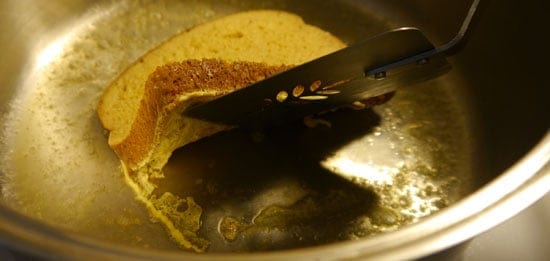
Yep. Big difference. The second side actually stuck worse.
How to Season a Pan
Seasoning a pan is really simple and takes about ten minutes, with some of that time spent letting the pan cool. Be sure to read all the way to the bottom for information on caring for your seasoned pan. Do not do this if the boat is rolling or there are large wakes, etc. — very hot oil is involved!
It’s also good to do on a day when you can totally open the boat up, because smoking oil doesn’t smell great. If you have a smoke detector, turn it off (pull the battery) until you’re finished — I can pretty much guarantee it’ll go off otherwise!
Begin by scrubbing the pan well, particularly if it’s not brand new. I usually use baking soda and some type of a scrubby. You can also use cleanser or even salt. Don’t add water — just scrub thoroughly.
I use my fingertips to make sure there aren’t any tiny little bits of anything stuck — the pan must be perfectly clean to start or you will have sticky spots.
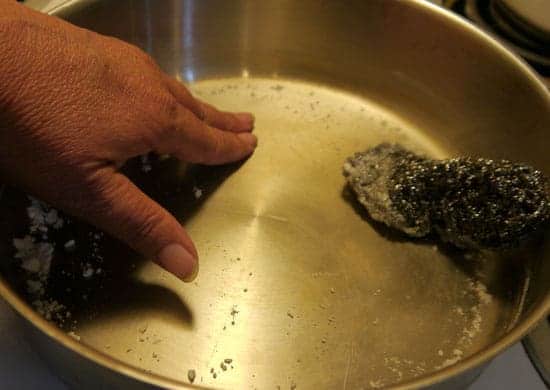
Once you’re convinced it’s perfectly smooth, rinse and dry (get it as dry as you can so the oil doesn’t spit in the next step). Before you go any further, put on at least a t-shirt if you’re wearing a swimsuit. You’re going to be working with really hot oil and if any spits up, you want a bit of protection.
For the next step, you can use any fat that smokes at a high temperature. Most oils will work, although extra virgin olive oil and butter both smoke at too low a temperature. Most margarines are not good to use as they have water in them (particularly any marketed as reduced calorie). I usually use canola oil, corn oil or vegetable oil (anything marketed as “frying” oil should also be okay). Bacon fat and lard are traditional fats to use, too. Here’s a handy chart of the smoke points of various oils if you’re wondering about some other oil.
Add enough oil to the pan so that the bottom is fully covered. Most pans will have some spot that is high and you need to make sure this is covered by about 1/8″ (3mm), not just coated with oil. If it’s just coated, you’ll end up with a sticky spot around the high spot. (Yes, this is one of those jobs where details count.)
Place the pan on the stove over high heat and heat until the oil smokes — this should take less than 2 minutes.
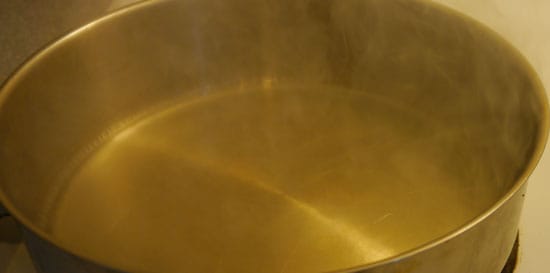
Once it is smoking, turn the burner off and let the pan sit until cool enough to handle.
When it’s cool enough, pour the oil out and discard it. Wipe the residual oil out with a rag or paper towels. You may notice a bit of an “edge” at the bottom sides of the pan, where the top of the oil was. This is fine — don’t worry about it and don’t try to scrub it out (you’ll end up scrubbing part of the bottom and will remove the seasoning). Also, don’t wash the pan out with soap. Your pan is now seasoned.
A properly seasoned pan has almost a mirror quality to it — quite different from just a pan with a coating of oil:
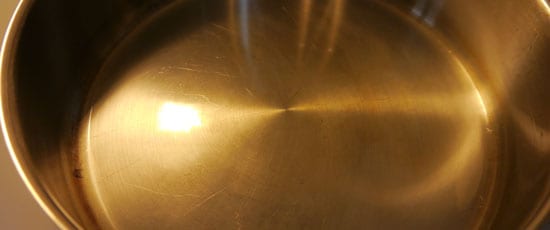
Care and Use of a Seasoned Pan
While you can saute foods in a seasoned stainless pan without adding any oil or other fat, I usually add just a touch of oil . . . because my mom did. I did recently try getting away from this, and discovered that after just 2 or 3 uses, I’d have a few small sticking spots. And they’d grow with each additional use until I re-seasoned the pan.
The key to keeping a seasoned pan “non-stick” is to use as little soap on it as possible and never use a scrubby or any sort of scouring powder. The best thing to do is just to wipe the pan out with a rag after using it, or if that won’t cut it, just use water and a dish cloth with just a bit of texture, such as the Scrubrs. If you really have, use a little soapy water.
If something does stick — it happens, particularly over time — simply scrub it totally clean and re-season it. Depending on what I’m cooking, I may re-season mine once a month or once a year.

Carolyn Shearlock has lived aboard full-time for 17 years, splitting her time between a Tayana 37 monohull and a Gemini 105 catamaran. She’s cruised over 14,000 miles, from Pacific Mexico and Central America to Florida and the Bahamas, gaining firsthand experience with the joys and challenges of life on the water.
Through The Boat Galley, Carolyn has helped thousands of people explore, prepare for, and enjoy life afloat. She shares her expertise as an instructor at Cruisers University, in leading boating publications, and through her bestselling book, The Boat Galley Cookbook. She is passionate about helping others embark on their liveaboard journey—making life on the water simpler, safer, and more enjoyable.
Simplify meal prep on board with proven strategies for provisioning, maximizing fridge space, and cooking delicious meals aboard your boat.
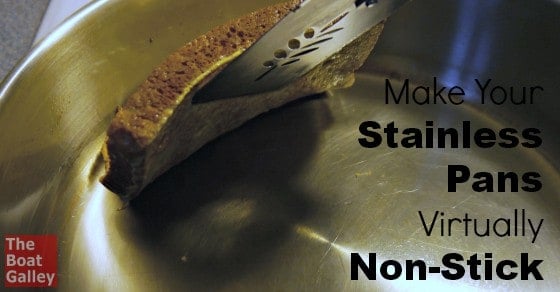


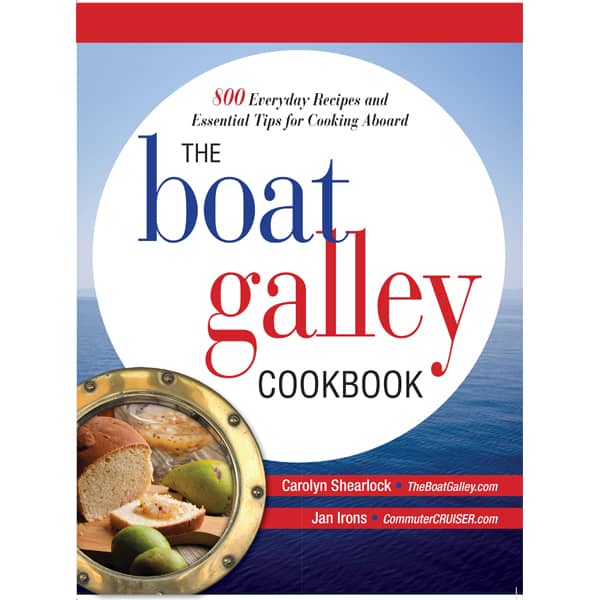






Sherry Day says
How timely! I just got a SS pressure cooker and am experimenting with recipes. I will season it before I continue. Thanks.
Sherie Lynn says
Wow, I´ve always hated SS skillets (ended up recycling them). Now I know it was just my ignorance…thanks Caroline for educating me!
Robin Van Auken says
Hmmm, will try this today. Instead of seasoning it on the stove, however, I´ll try it on the side burner on the grill outside. That way my smoke detectors won´t go bonkers.
Suzanne Mummert says
I bought all new, very high quality, SS when we moved aboard 10 years ago. I seasoned the entire set but for a totally different reason, water conservation! With seasoned cookware, I rarely need to use water to wash as a quick wipe is all they need. In 10 years I have only re-seasoned my pans once or twice and soap has never touched them.
Sara Peterson says
There is a universal way to get any pan to be non-stick. It is to heat the pan first to a point where when you flick drops of water onto the surface of the pan, they roll around in drops. Once the pan has reached that temperature, add your oil/fat. Nothing sticks to the pan if you do that. It is really great. Scrambled eggs included in that! : )
John says
What you see is called the Leidenfrost effect.
And with water, it means the temperature of the surfacevis above 260°F, which makes the water droplet float around on a thin layer of steam.
A physics professor at Cleveland State University used to demonstrate the effect with a drop of liquid nitrogen on his tongue, until the time the droplet contacted a couple of teeth and cracked them so bad he had to get crowns.
barfwinkle says
Who Knew! We certainly didn’t. Tnx
Herb S, says
i remember when i was a kid mid 70s dad took us all out for dinner then to park city lanc. pa. any way i dont remember the occasion but my father purchased a really nice ss cook were set. that sales women told my parents this is the best think going right now as far as cook were. we got the stuff home mom started cookingand the shit started sticking and she started throwing those ss pots and pans right out the F******* door into the yard. we had no idea that they needed to be seasoned first before useing. afer learning this 40 yrs later i told my ma that i just watched this segment on your class. and how to make a ss frying non stick. she shook her head and laughed at me and said how in h*** do you remember that Herb i was only 12 any way thank you iam going to try this is peanut oil one of your better oils to use? thanks,Herb S.
Carolyn Shearlock says
Great story and so sorry to hear it! Peanut oil is a good choice — it has a slightly higher smoke point than the canola oil that I used. The deal with getting it to smoke is that it heats the metal up to the point that its pores “open” (that’s probably not the technical term!) and the oil can bond with the metal.
Let me know how it goes!
Beverly says
I went to the link to order these scrub buds and the drops and it said on both, “No longer available.” It didn’t say that they were out of stock, just no longer available.
Carolyn Shearlock says
I checked and it seems that they changed the packaging and therefore the link changed. I updated it so you can use it now. Sorry about that!
peggy at ECY says
I’m in Sara’s camp… A hot pan doesn’t stick… I heat pan first, then add food… But seasoning would save water… Have to do that for next long cruise. Love my $40 SS set from Walmart… Have had expensive and bought this set for the boat… Love it more then my fancy set, so got another for home.
chathurika819 says
I was about to give up making french toast for my 3 yr old son in my newly bought ss skillet. Thanks a lot for the tips Carolyn. I used coconut oil for the seasoning and it works like magic.!
Mike M says
Won’t the ss frying pan become a health hazard if it’s not properly washed after every use?
Carolyn Shearlock says
If nothing sticks, there’s nothing to cause a problem.
Tony says
I agree, the pan is cleaned, there are no ‘bits’ left to promote growth. Any “potential contaminates” would also be killed in the preheat stage the next time you use it.
I follow this same routine in my cast iron pans, have not washed them in years, but they are clean!
Mike M says
I still cannot bring myself to just wiping the pan with kitchen towel! To me, it feels like not washing one’s hands after going to the bathroom. Anyway, a quick rinse under hot water doesn’t seem to make any difference to the pan’s “non stick” ability.
Helena Alexander says
I have used seasoned cast-iron all my life, as did my mother and my grandmother. We never use soap! A rinse with warm water is fine; it does not seem to hurt anything; and even a soft bristle scrub brush is OK if absolutely needed, as long as you don’t use any soap!! But, just a nice wipe with a towel or even paper towel is preferred! Three generations and no one has gotten sick or died yet! Any leftover food actually turns to carbon at a high enough temperature. Carbon is naturally nonstick. Watch next time you are at a Benihana! LOL
chuck says
They do not “wash” seasoned grills at restaurants, they just scrape them down and rub the pumice on it. This is the same thing done to cast iron pans and skillets…
Stasea Arnold says
I’m liking it too!!
Stephanie Hamilton says
I have a set of All-Clad SS pots and pans and I never seasoned them. I DO scour them with Barkeeper’s Friend after using, though. I have never had a problem with stuff sticking but that may be because I have learned not to go all “Iron Chef” on everything and move it all around. I leave stuff (meat, poultry, veggies) alone in the pan for several minutes and, it releases itsownself when it is ready to be turned… I will check out this seasoning business, though. You have such GREAT tips!
Jane Gammons says
This seasoning is the same for cast iron .
Clair Weslee says
Thx, John R. Parsons for bringing up The Boat Galley, fun stuff here!
Maria Cullum says
Thank you, I will definitely do this.
Tony Bentley says
Flax seed oil is the best due to the very high smoking point and low viscosity. I use it for cast iron but nonstick can be applied to any bare metal. Nonstick is polymerized oils that bond at a high temp, so the higher the smoking point the better the bond. The next time you fry something and hit smoking point, you’ve also just cooked off your seasoning. Something to think about. Also washing with saltwater seems to eliminate the need for oxalic acid when reapplying the coating.
Candy Ann Williams says
Wow! I always seasoned my black skillets but never knew I could do this with my SS ones! Again, you share great tips…thanks!!
Cheryl Bular says
Thanks. Love SS but hated the sticking.
Laine Common says
Ss is sooo much better than toxic nonstick Teflon! We love our ss set. I’m just worried about how large my pans are once we move onto our boat. I don’t want to part with any due to space! Lol
Hilary Helkenn says
Awesome! I will try this. However, how does it work for searing meats when you want a bit of the leg over bits to season your veggies or sauce? I’ve been working on the learning curve of my Magma pans and I sautée most of our meats as the wind in SF makes the grill difficult to use much of the time. I’ve learned to add a little water while pan is warm when I’m done cooking, then that gets all the stuck food off the bottom. I’d like the ease of non-stick but like how flavorful foods are when prepared this way.
The Boat Galley says
Food still browns, it just doesn’t stick. Tastes just the same. If you want to use a bit of oil or butter for flavor when you brown something you can.
Mike M says
Absolutely! The caramelisation is what gives the meal that special savoury taste. And the beauty of ss pans is you can really get in there and scrape the bottom with a ss spatula to get all that goodness off, something you cannot do with non-stick pans. It doesn’t even have to be meat. If you saute mushrooms in butter, turn up the heat and fry ’em really fast, turning all the time. Sprinkle a little Knorr stock powder or equivalent over the ‘rooms and then after a few seconds you’ll start to see caramelisation. Then in with a tablespoon of water and scrape, scrape, scrape with the spatual! Delicious. Toss in a few prawns at the end.
Lauren Reese Dehaan says
Thank you for this information. I will definitely do this to my stainless cookwsre.
Krysta Schwanz Dehnert says
This was the web page you were talking about, right?
Outland Hatch Covers, LLC says
Very cool! I am going to try this. I knew about seasoning cast iron skillets but never knew it could be done with stainless. Thank you!
John R. Parsons says
Here’s how we applied your awesome advice:
https://www.facebook.com/media/set/?set=a.590315624465041.1073742163.100004598250156&type=1&l=0b4ba5c103
Sharon Ellens says
Thanks, Carolyn, for your awesome website and plentiful tips. My husband and I have used many of them.
I received a set of Magma ss pans for Christmas, and am just now getting around to seasoning them (its finally Spring in Michigan — we had snow a couple of weeks ago!) Anyway, a word of caution from my experience — after heating them to smoking the way Carolyn suggests, I thought I’d be clever and put them on hot pads/trivets outdoors so the smoke wouldn’t continue to accumulate in the house. I ended up with burn marks on a wooden trivet and crocheted hot pads. I also managed to melt a silicone hot pad which stuck to the bottom of the pan. Obviously they are *VERY* hot at first.Next time I will let them cool off a bit on the stovetop before moving them.
Kaye Smith says
My BIL uses salt to clean his stainless steel, no water ever touches his pans Also he only places food in the pan when it is HOT to keep it from sticking. He doesn’t season with oil either. He worked as short order cook and claims this was true in some restaurants as well. So far we have tried this with good results.
Shawna Soto says
This is great news!! Should I do this with all my stainless including pots??
Carolyn Shearlock says
It works well on baking pans, too. If you have a problem with food sticking in your saucepans, you can season them too.